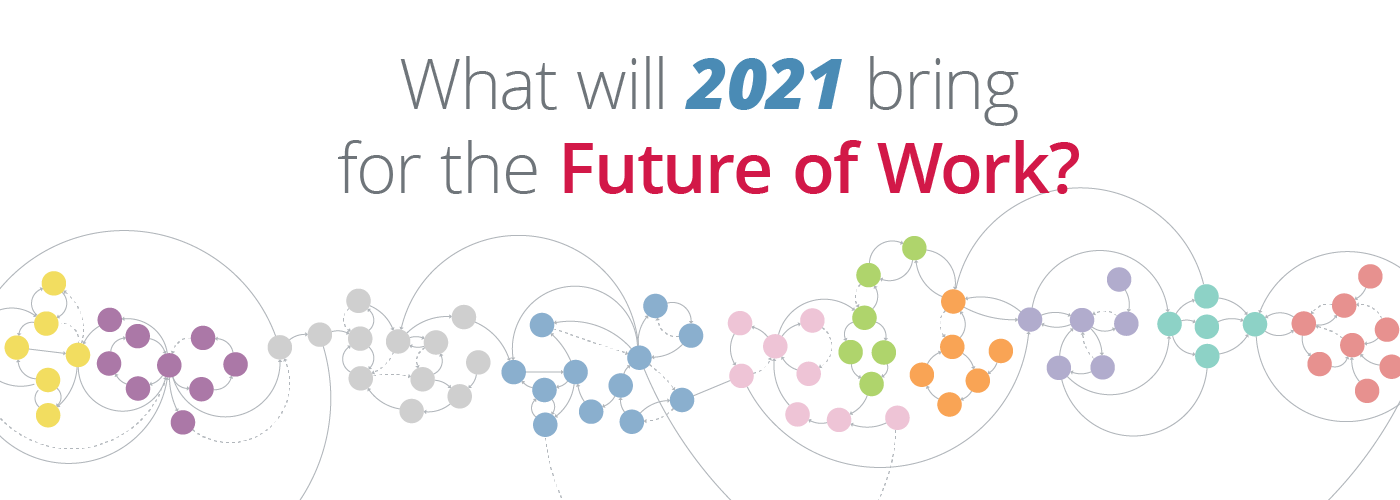2021: A look into the Future of Work for the year ahead

The COVID-19 pandemic has impacted all of our realities in major life-altering ways, from local communities to global fronts. As a result, those of us who concern ourselves with the “Future of Work” have shifted our attention to how the current pandemic is bringing about immediate changes that were once predicted to occur in the near, and even, far future. The SourceAmerica® Workforce Development team had many thoughtful discussions on this subject. We identified three trends that have surfaced in the previous year which will become important and prominent in 2021 and beyond.
Telework as the new work modality
With the COVID-19 pandemic that unfolded in 2020, millions of workers across the globe began doing their work from home. Telework has quite dramatically become the new work modality. Conversing and collaborating with colleagues virtually and digitally has become the new norm. Slowly yet surely, technological solutions are being created and applied to increase telework accessibility, allowing more people with disabilities access to telework. For example, deaf and hard-of-hearing individuals are finding creative ways to utilize teleconferencing platforms to enable working with colleagues, and the ability to have American Sign Language interpreters join in. That recently developed feature makes telework more accessible. We can expect to see additional enhancements made across the employment sector that continues to encourage the growth of job opportunities for people with disabilities.
Automation as the new work reality
The increase and spread of automation in various domains of work has been “the writing on the wall” and the topic of many Future of Work conversations among subject matter experts. Implementation of automation across various fields within the employment sector is being fast-tracked due to the nature of the pandemic, evolving nature of work, and the increasing demands for various products and services despite the pressures on the workforce. For example, the COVID-19 pandemic has forced a closer look at sanitization practices.
The AbilityOne® Program is one of the largest employers of people with disabilities in the nation. SourceAmerica is an AbilityOne-authorized enterprise and connects government and corporate customers to a national network of over 700 nonprofit agencies that hire a talented segment of the workforce – people with disabilities. A significant portion of the work performed through the AbilityOne Program is custodial in nature. Automation, for multiple reasons, is being applied sooner than expected, due to the increased demands for sanitary and sterilized environments. At this point in time, SourceAmerica is having an ongoing conversation with nonprofit organizations about the benefits and importance of automation in the development of products and provision of services. Rather than the utopian vision of replacing human workers, automation is being implemented alongside human beings. This effort is enhancing the work experience and increasing efficiency and productivity. You can read more about this in detail in the published white paper Impact of Automation in the Custodial Marketplace.
Inclusion as the new work challenge
Inclusion of the disadvantaged, those in poverty, marginalized communities, and people with disabilities, in the ever-evolving remote workforce will continue to be our challenge in 2021. As SourceAmerica Vice President of Workforce Development Shane Kanady said in a recent report, How COVID-19 is Reshaping the Future of Work for Persons with Disabilities,
“The discussion on the future of work is being reshaped as we are pushed into mandatory telework, increased reliance on technology and a greater understanding of the fragility of traditional service-sector jobs. There is reason to be concerned about the long-term impacts that will be felt by the disability community. If we do not adopt a more inclusive perspective on the labor market and recognize the inherent value and contributions of the community, any progress achieved during the intervening ten years is likely to be lost. We can hope that there will be positive consequences in response to the chaos and tragedy of the current situation – but they will not take place without purposeful action by policymakers to swiftly address the unique issues facing the disability community.”
We have witnessed stark changes this past year that have impacted all of us, sparing none. In 2021 we can expect to see common trends as we survey the extended impact and employment-related consequences – both negative and positive – of the pandemic. A new Administration may bring new priorities to the table, including an increased focus on continuing to bridge the ever-widening gap in the labor force, exacerbated by the current pandemic. 2021 – and the Future of Work – will show that telework, automation and inclusion are key ingredients to navigating a prosperous pathway forward for people with disabilities.
Enjoy this? You might like these stories, too: